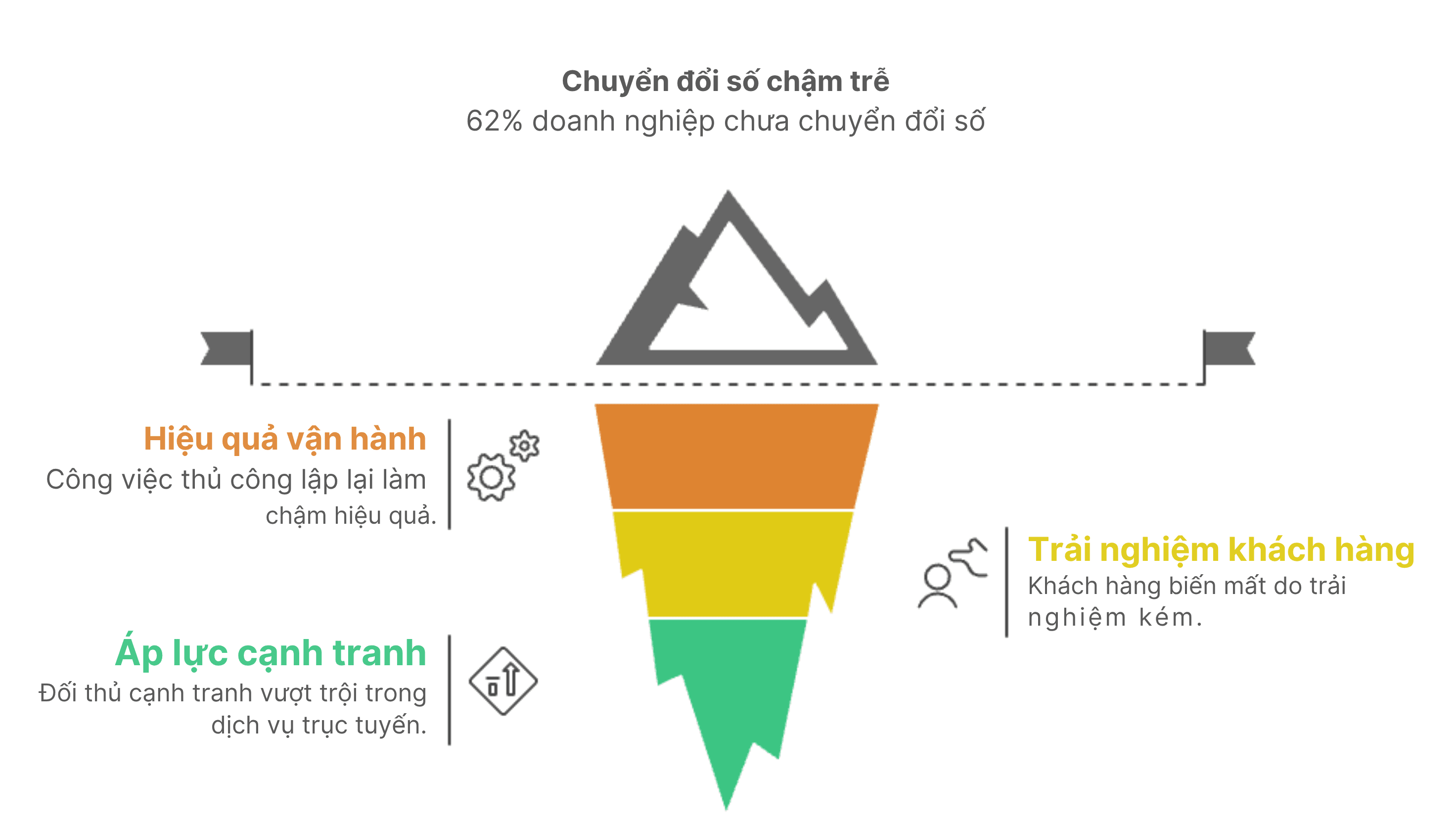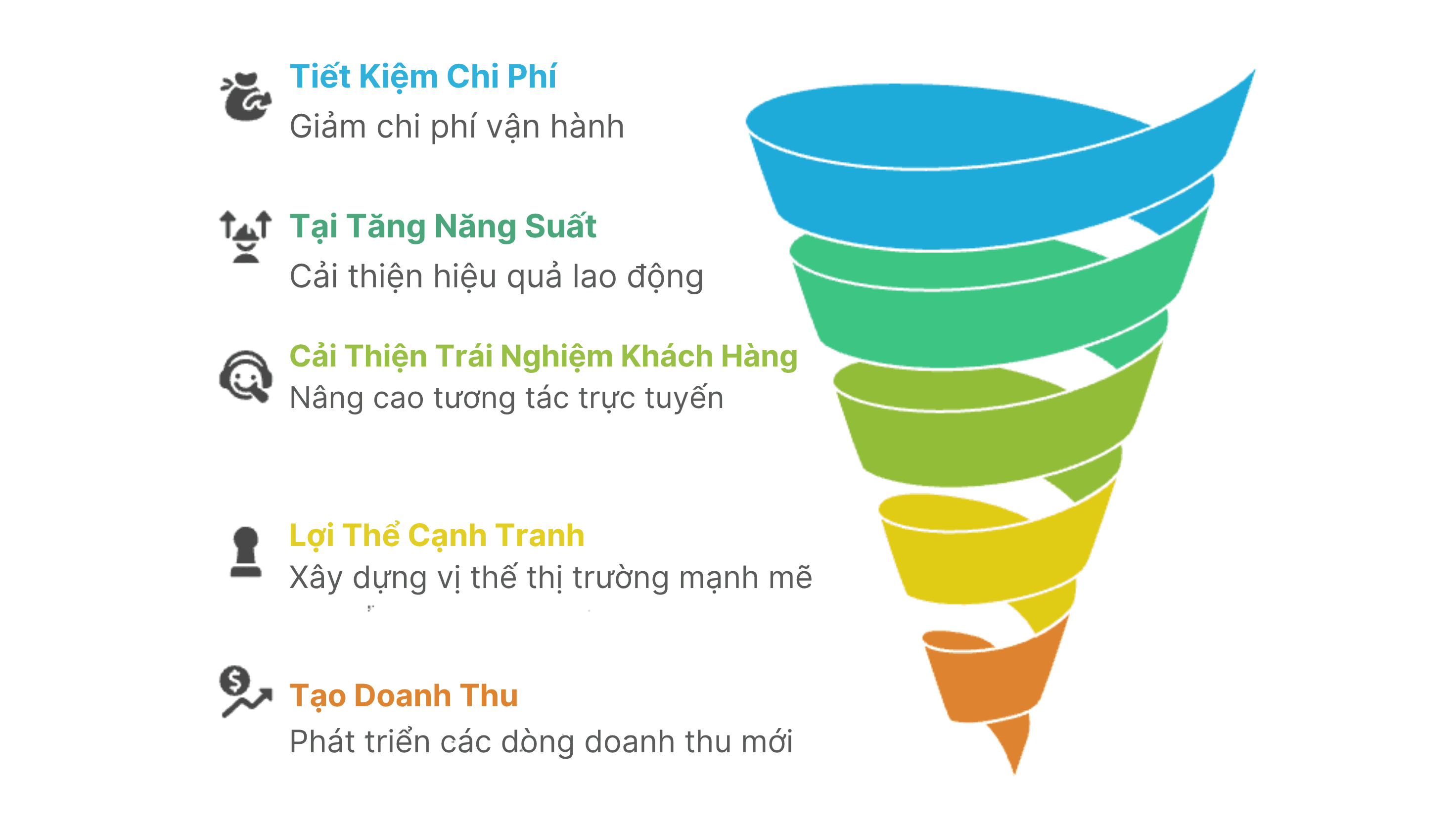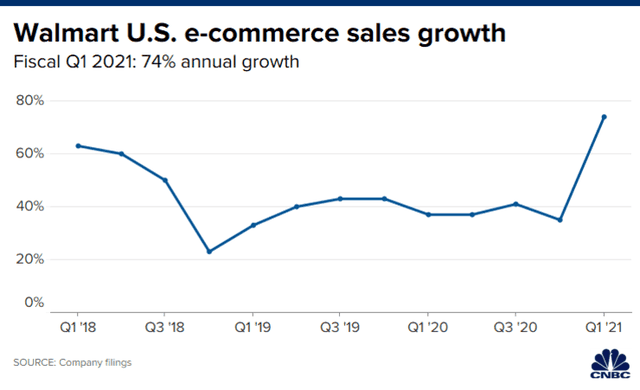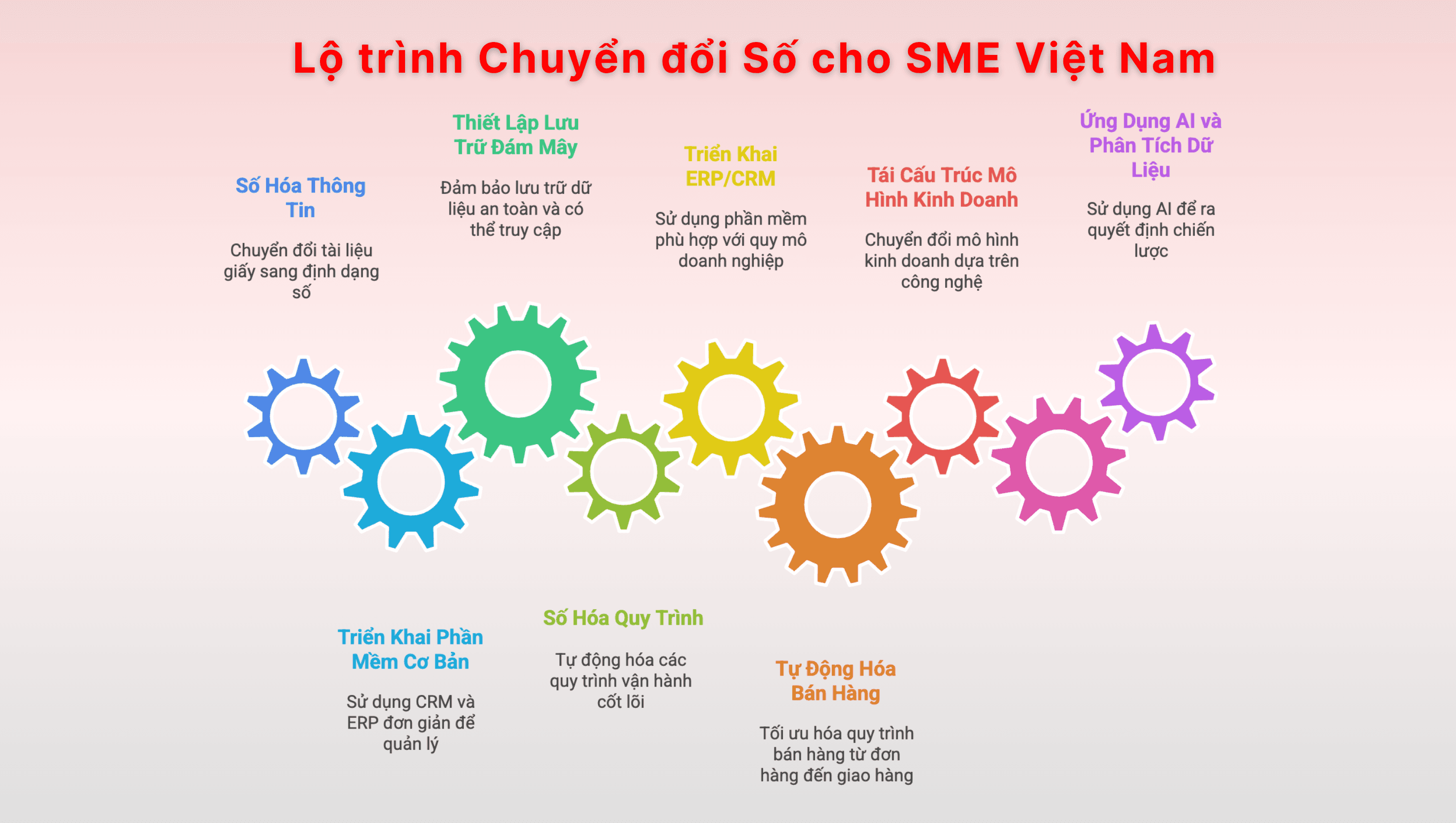What is Digital Transformation? National Vision
Digital transformation is a comprehensive process of integrating digital technology into all areas of business operations, thereby fundamentally changing the way businesses operate and create value for customers. This is not simply digitizing documents or using management software, but a comprehensive change in business models, operational processes, and corporate culture.
Digital transformation includes three core components clearly defined by international organizations. First is information digitization: converting data from physical format to digital format for easy storage, access, and processing. Second is process digitization: applying technology to automate and optimize business processes to improve efficiency and minimize errors. Third is business model transformation: creating entirely new ways to create value and interact with customers through digital platforms.
For Vietnamese SMEs, digital transformation means leveraging the power of data to make smarter decisions, using automation and AI agents to reduce operational costs, and connecting with customers through diverse digital channels. The ultimate goal is to create sustainable competitive advantages in a business environment increasingly shaped by technology.
National Vision for 2030 on Digital Transformation
National digital transformation is Vietnam's overall development strategy, reflected in the "National Digital Transformation Program to 2025, with orientation to 2030" approved by the Prime Minister according to Decision No. 749/QD-TTg dated June 3, 2020.
Vision to 2030
Vietnam becomes a digital, stable and prosperous nation, pioneering in testing new technologies, in which the digital economy reaches about 30% of GDP and ranks among the top 50 countries in the world in e-government and digital economy.
National Digital Transformation Agency
An agency under the Ministry of Information and Communications - plays a key role in advising, coordinating and promoting national digital transformation. This agency is responsible for state management of information technology applications, developing digital government and synthesizing digital transformation activities nationwide.
Three pillars of national digital transformation:
Digital government aims to modernize the state apparatus, improve management efficiency and serve the people. Digital economy focuses on developing digital industries, promoting businesses to apply technology and create new business models. Digital society aims to digitize social services, education, healthcare and culture, creating conditions for all people to access and benefit from digital technology.
Results achieved so far:
According to a survey by the Vietnam Chamber of Commerce and Industry (VCCI), 25.7% of businesses have started applying technology to operations. More than 200,000 businesses use electronic invoices, 20% of advertising budgets are spent on digital marketing, and 79.7% of high school students studied online during the COVID-19 period - higher than the average of OECD countries (67.5%).

Signs of the "Golden" Time for Business Digital Transformation
Identifying the right time to implement digital transformation can determine the success or failure of the entire strategy. According to research from Huawei Enterprise, 62% of global businesses have not achieved the level of digital transformation necessary to capitalize on opportunities from the digital economy.
Signs of operational efficiency:
Recognizable through the phenomenon of "many staff but no visible results." Employees spend 60-70% of their time on repetitive manual work such as duplicate data entry, creating reports by hand, or searching for information in piles of paperwork.
Specific examples: The same customer information must be entered 3 times (logbook → Excel → accounting software). To know which product sold best this month, employees spend the whole day searching through books. A restaurant has 10 employees but customers still wait long because of manual order-taking processes.
Signs of customer experience:
The most dangerous sign is when regular customers "disappear" for unknown reasons. They don't complain but simply switch to competitors with better experiences.
Warning signals: Customers ask "Why don't you have an ordering app like other companies?", "Why can't I pay with QR code?". Generation Z increasingly has less interaction with businesses because there are too many more convenient options. Customers have to wait long to receive feedback or order confirmations.
Signs of competition:
Are competitors in the same industry attracting customers with online services that you don't have? Can they respond to customers faster, provide more transparent information, or have more convenient ordering processes?
Real story:
A fashion retail store in District 1, Ho Chi Minh City with 15 years of operation witnessed a 40% decrease in revenue in 2020. After implementing an automated inventory management system and online sales platform, the business not only recovered but also grew 25% compared to pre-pandemic times.
The Role of Digital Transformation in Business
Role of digital transformation:
Digital transformation plays the main driving role in helping businesses adapt and develop in a VUCA business environment (volatile, uncertain, complex and ambiguous). It is not only a tool to improve operational efficiency but also a decisive factor in the survival and competitiveness of businesses in the digital age.
The role of creating sustainable competitive advantages through optimizing processes, improving customer experience and developing new products and services. Digital transformation also acts as a bridge helping businesses access global markets and connect with international partner ecosystems.
Specific manifestations of digital transformation:
In the operational field, the clearest manifestation is replacing manual processes with automated systems, from warehouse management, order processing to financial reporting. In the customer aspect, digital transformation is manifested through providing omnichannel services, personalizing experiences and quick response through digital platforms.
Organizationally, manifestations of digital transformation include flexible work culture, data-driven decision making and the ability to quickly adapt to change. In business, digital transformation is manifested through developing new revenue models such as subscription, marketplace or platform business.

Benefits that Digital Transformation Brings
The digital economy has become the main growth driver of developed countries. China reached $5.4 trillion, accounting for 40% of GDP in 2020 and helped the country maintain 9.6% growth during the pandemic. Australia invested 800 million AUD in the digital economy plan, expected to increase GDP by 6.4 billion AUD by 2024, showing the strategic importance of digital transformation.
Short-term benefits for Vietnamese SMEs (6-12 months):
Implementing basic digitization solutions can bring 20-30% operational cost savings in the first year. Labor productivity increases 15-25% by eliminating manual work and automating processes. Manual work processing time decreases 40-50%, helping employees focus on higher value-added activities.
Customer experience is immediately improved through online interaction channels and quick responses. With 93% of the global population having mobile internet connectivity and 4G covering 85% according to Huawei reports, Vietnamese SMEs have the opportunity to access broader markets than ever before.
Medium-term benefits (1-3 years):
Digital transformation helps SMEs build sustainable competitive advantages in the rapidly developing sharing economy. Collected data creates a solid foundation for developing new products that meet market needs. Market expansion capacity is no longer limited by geography, allowing businesses to reach national and even international customers.
A modern digital work environment helps attract and retain young talent, especially important when over 50% of global CIOs have difficulty recruiting digitally skilled talent.
Long-term benefits (3-5 years):
1. Proven crisis "resistance" capability
COVID-19 has proven: businesses that have digitized not only survived but also grew.
Example: Walmart increased online revenue by 74% in Q1/2020. Vietnamese SMEs with similar digital foundations can maintain operations and grow in any crisis situation.

2. Creating additional revenue sources from data and platforms
After 3-5 years, SMEs can develop new revenue streams such as selling customer insights, creating new services, or developing marketplaces.
Example: Amazon from a bookstore to AWS cloud services driving revenue growth. SMEs can apply similar models in their vertical industries.
3. Competing with giants through experience quality
In digital space, company size is less important than product and service quality.
4. Building a "data ecosystem" that's hard to imitate
After 3-5 years of data collection, SMEs can apply AI/Machine Learning to create sustainable competitive advantages. More data means smarter algorithms, better products, attracting more customers, creating more data - this is the "data flywheel effect" that Google and Amazon use to maintain their leading positions.
3 Levels of Digital Transformation
According to experts and Vietnam's Ministry of Information and Communications, digital transformation in businesses is divided into three clear levels, each with different objectives and implementation methods. Understanding these three levels correctly helps businesses determine their current position and develop appropriate development plans.
Level 1: Information digitization (Digitization)
This is the first step in the digital transformation journey, focusing on converting data from physical to digital form. This process includes digitizing paper documents, customer records, inventory data and other important business information. Although simple, this level creates a solid foundation for subsequent steps and helps businesses get familiar with digital technology.
Level 2: Process digitization (Digitalization)
At this level, businesses begin applying technology to automate and optimize operational processes. Implementing management software, ERP/CRM systems and automation tools helps improve work efficiency and minimize errors. This stage changes the way of operation but has not yet impacted the core business model.
Level 3: Comprehensive digital transformation (Digital Transformation)
The highest level of digital transformation requires fundamental changes in business model, corporate culture and value creation methods. Businesses not only use technology as a support tool but make technology the DNA of the organization, creating entirely new ways to serve customers and compete in the market.

Effective and Cost-Saving Technology Implementation Steps
Step 1: Current situation assessment and goal setting
Technology audit according to three main pillars recommended by international experts. Assess data and analytics capabilities, including capacity to collect and process the massive data volumes expected to reach 180 ZB by 2025. Check skills and automation capabilities of current personnel.
Assess infrastructure and cloud migration readiness. Identify priority "pain points" to solve and set SMART goals for each development stage.
Step 2: Choose appropriate technology solutions
Five important selection criteria for Vietnamese SMEs: easy-to-use interface without complex training, reasonable costs that can be divided into small payments according to OPEX model, Vietnamese language support and customer service in Vietnam, flexible scalability according to business scale and high integration with other software.
Step 3: Build data & AI capabilities
Deploy AI-supported data analytics solutions to optimize decision making. Automated business intelligence helps leaders have a comprehensive view of business situation. Create enterprise platforms based on data and leverage 80% unstructured data to improve customer experience.
Step 4: Prepare personnel and culture
Train pioneer teams to address the situation where over 50% of CIOs struggle to recruit digital talent. Deploy intelligent automation for end-to-end processes instead of just focusing on individual tasks. Build policies encouraging cooperation between humans and machines.
Step 5: Pilot implementation and expansion
Start piloting with one or two departments to verify effectiveness and make timely adjustments. Collect user feedback and optimize processes. Gradually expand to the entire enterprise according to cloud-centric model to ensure flexibility and scalability.
Step 6: Continuous measurement and optimization
Establish KPIs to measure effectiveness according to four main impacts: economic growth, job creation, market expansion and capacity development. Monthly and quarterly periodic reviews to adjust strategy based on actual results and market fluctuations.
5 Biggest Challenges for Vietnamese SMEs
Challenge 1: Skills gap
With over 50% of global CIOs struggling to recruit talent with sufficient digital skills, Vietnamese SMEs need to focus on investing in intelligent automation to replace repetitive work and train existing employees. Starting with robotic process automation for administrative tasks will free up human resources for higher value-added work.
Challenge 2: Limited budget
Applying OPEX model through cloud computing helps reduce initial investment costs and allows payment according to actual usage. Prioritize high ROI solutions and implement step by step to effectively allocate budget. Take advantage of incentive programs from the Vietnamese Government for SME digital transformation.
Challenge 3: Legacy IT infrastructure incompatibility
Most SMEs currently have many scattered IT systems that cannot connect with each other. The solution is to move to cloud-centric infrastructure and modernize legacy applications step by step. Start with hybrid cloud model to minimize risks and conversion costs.
Challenge 4: Limited data utilization capability
Over 50% of businesses have limited vision of their enterprise data. Deploy AI-powered analytics and create data-native enterprise is the core solution. Start with structured data before moving to unstructured data processing to ensure accuracy and efficiency.
Challenge 5: Employee resistance to change
Deploy human-machine collaboration model instead of completely replacing humans with machines. Train step by step and focus on augmenting human capabilities instead of replacing workers. Link individual KPIs with technology use to create positive change motivation.
Successful Digital Transformation Examples in Vietnam

EVN (Vietnam Electricity Group) is among the leading enterprises in digital transformation in Vietnam. By September 2022, the group had completed 85.5% of the planned digital transformation.
EVN's digital transformation strategy is implemented synchronously on five main pillars: internal governance, investment and construction, production, customer service business along with information technology and telecommunications.
In internal governance, EVN has achieved impressive results when 100% of affiliated units deploy Digital-Office systems. All reports in the group are processed in electronic form, while digital signatures have been widely applied at management levels.
In the field of investment and construction, the group has digitized many important processes such as electronic construction diaries and acceptance records. Project file management is also performed entirely on electronic platforms. Especially, EVN is one of the pioneer organizations to successfully deploy online bidding systems.
For production, business and service activities, EVN has comprehensively applied digital technology. The group has deployed 21.1 million electronic meters and provides 100% online electricity services. This system supports multi-channel, multi-platform connectivity in digital environments, bringing optimal experience to customers.
FAQ - Answering Questions About Digital Transformation
Q: Do small businesses need digital transformation?
Yes, and very urgently. Statistics show that 70% of SMEs that don't undergo digital transformation will be eliminated from the market in the next 5 years due to inability to compete with digitized competitors. Starting with a modest budget of 10-30 million VND can still bring clear effects on productivity and customer experience.
Q: How to know which technology provider is trustworthy?
Choose providers with similar-scale customers in the same industry. Ensure they provide free trials or demos to verify capabilities. 24/7 support in Vietnamese and international security certifications are indispensable criteria. Refer to reviews from current customers to evaluate service quality.
Q: Will data be lost or leaked?
Risk is very low if choosing reputable providers with international security certifications. Cloud computing is actually safer than internal storage in 99% of cases thanks to multi-layer security systems and automatic backup. Data loss due to local hardware failure is more frequent than cloud incidents.
Q: Is digital transformation suitable for all industries?
Yes, but the level and implementation methods differ. Service industries usually transform faster than manufacturing due to fewer physical equipment constraints. However, all industries can apply digitization at least at management and sales levels. The important thing is to correctly identify priorities and roadmaps suitable for industry characteristics.
Conclusion
Digital transformation for Vietnamese small and medium enterprises is not just a trend but has become a vital factor in the digital economy. With a clear roadmap, reasonable budget and commitment from leadership, all SMEs can succeed in this digitization journey. Start today to not be left behind in the Industry 4.0 technology race.
